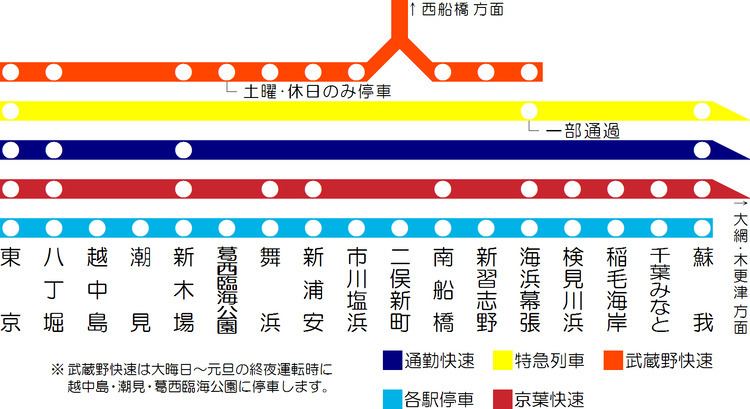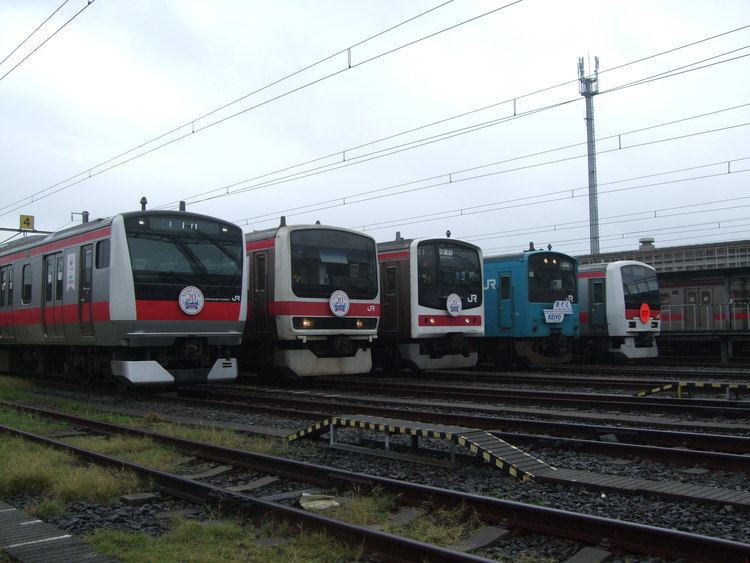Native name 京葉線 Status Operational Opened 1975 | Stations 18 | |
 | ||
Chiba japan keiyo line train arrives at maihama station hd 2015
The Keiyō Line (京葉線, Keiyō-sen) is a railway line connecting Tokyo and Chiba in Japan, paralleling the edge of Tokyo Bay. It is operated by the East Japan Railway Company (JR East). The line forms part of what JR East refers to as the "Tokyo Mega Loop" (東京メガループ) around Tokyo, consisting of the Keiyo Line, Musashino Line, Nambu Line, and Yokohama Line. It provides the main rail access to the Tokyo Disney Resort and the Makuhari Messe exhibition center. The terminus at Tokyo Station is located underground, some distance to the south of the main station complex approximately halfway to Yūrakuchō Station. This means transfer between other lines at Tokyo Station can take between 15 and 20 minutes. The name "Keiyō" is derived from the second characters of the names of the locations linked by the line, Tokyo (東京) and Chiba (千葉). It should not be confused with the Keiō Line, a privately operated commuter line in western Tokyo.
Contents
- Chiba japan keiyo line train arrives at maihama station hd 2015
- Chiba japan keiyo line train travels past the tokyo disneyland resort hd 2015
- Services
- Station list
- New station development plan
- Rolling stock
- Rolling stock used in the past
- History
- Timeline
- References

Chiba japan keiyo line train travels past the tokyo disneyland resort hd 2015
Services

Station list

New station development plan
There is a new station construction plan between Shin-Narashino Station and Kaihimmakuhari Station.
Rolling stock
All Keiyo Line rolling stock is based at the Keiyo Rolling Stock Center near Shin-Narashino Station

Rolling stock used in the past

History
The Keiyo Line was initially planned as a freight-only line. Its first section opened on 10 May 1975 as a 6.5 km link between the Chiba Freight Terminal (now the Mihama New Port Resort between Inagekaigan and Chibaminato Stations) and the freight yard next to Soga Station. Passenger service began on 3 March 1986 between Minami-Funabashi and Chibaminato, and was extended eastward to Soga and westward to Shin-Kiba on 1 December 1988.
The final section of the Keiyo Line between Tokyo and Shin-Kiba opened on 10 March 1990. The platforms at Tokyo Station were originally built to accommodate the Narita Shinkansen, a planned (but never built) high-speed rail line between central Tokyo and Narita International Airport.
Planners originally envisioned the Keiyo Line interfacing with the Rinkai Line at Shin-Kiba, thus providing a through rail connection between Chiba and the Tokyo Freight Terminal in eastern Shinagawa, and also completing the outer loop for freight trains around Tokyo formed by the Musashino Line. This original plan would also allow through service with the Tokaido Main Line, allowing freight trains from central and western Japan to reach Chiba and points east.
However, in the 1990s, as the artificial island of Odaiba began developing as a commercial and tourist area in the middle of the Rinkai Line route, the Rinkai Line was re-purposed for use as a passenger line. While there is a through connection between the Rinkai Line and the Keiyo Line, it is only used by passenger trains in charter service, usually carrying groups to the Tokyo Disney Resort.
